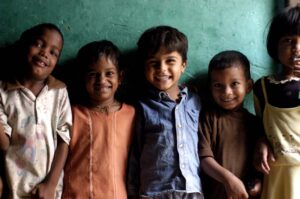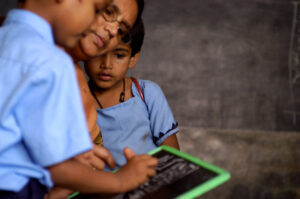 Sangeeta Sambhi, Keekli Intern
Sangeeta Sambhi, Keekli Intern
What is the literal meaning of education? According to the definition, given by various dictionaries, it is the teaching or training of people, especially in schools. We can further diversify the definition into the teaching and training, imparted at the various levels of primary, secondary and university bifurcations of semblance. Where on one side, education on the school level, is only restricted to studying simple subjects like, English, mathematics, science and social science, on the same lapse of ethos, it is also related to being aware of one’s rights, responsibilities and desires. With India’s population increasing by four times, in comparison to the year of Independence, i.e., 1947, we now account for about a quantitative population of 1.38 billion.
 As per the data provided by census 2011, India has a population of 472 million, when it comes to the children lying in the age group of 0-18 years of age, with nearly 26% of its population, comprising of children in the age group of 0-14 years of age. Adding onto it, India’s 50% population lies below the age group of 25 years, and approximately, 65% of its population lies under the age group of 35. To cumulate the quantitative figures, the most active age group, from revenue generation point of view, i.e., 15-64 years, accounts for 67.27% of India’s total population. With a gargantuan human capital, most of the children lying in the parameters of illiteracy are from that of the age group of 0-14 years. And then, the second highest illiteracy level, lies in the age group of 15-25 years. Illiteracy churning both the genders, if we prefer looking at the ratio of gender inequality of literacy, there will be a stark difference in the two. Where the literacy rates of males are moderate, on the same lapse of ignorance, the same percentage for females, staggers to be low.
As per the data provided by census 2011, India has a population of 472 million, when it comes to the children lying in the age group of 0-18 years of age, with nearly 26% of its population, comprising of children in the age group of 0-14 years of age. Adding onto it, India’s 50% population lies below the age group of 25 years, and approximately, 65% of its population lies under the age group of 35. To cumulate the quantitative figures, the most active age group, from revenue generation point of view, i.e., 15-64 years, accounts for 67.27% of India’s total population. With a gargantuan human capital, most of the children lying in the parameters of illiteracy are from that of the age group of 0-14 years. And then, the second highest illiteracy level, lies in the age group of 15-25 years. Illiteracy churning both the genders, if we prefer looking at the ratio of gender inequality of literacy, there will be a stark difference in the two. Where the literacy rates of males are moderate, on the same lapse of ignorance, the same percentage for females, staggers to be low.
A comparative analysis, would give us a better picture of the overall literacy rates:
| Gender | Literate population in 2011 | % of Population Literate in 2011 | % of Population Literate in 2021 |
| Total Population | 1,402,013,486 | 72.99% | 77.70% |
| Males | 717,100,970 | 80.89% | 84.70% |
| Females | 662,903,415 | 64.64% | 70.30% |
Less than half of the India’s population, comprising of children, 6-14 years of age, make up to be the privileged ones, to show-up and attend school on daily basis. Whereas, at least, an alarming figure of 35 million, does not get a chance to step into the doorway of learning how to read, write and speak. Girl child illiteracy rates, eviscerate, are on a high of 53%. Reasons being many.
India’s inhabited land, has only 53% area under primary schools, and a low of only 20% has secondary schools. Not only this, it is a snowballing issue, that approximately, 60% of primary schools, do not have teachers, to educate children from Class I-V, hence, adding onto the misery, of reducing human capital for the nation. Nearly 1 in every 40, primary school classes, are conducted in open tents, over being conducted in concrete structures and safe environments. This increases the chances of female students, not being sent to schools. It is an unfortunate truth, that 17 million children, are a victim of child slavery, hence, walking into the tacit nook of darkness.
Swerving into the health indices, 70 in every 1,000 children, do not get to experience their first birthday, their totality accounts to about 2 million. The infrastructural facilities also feign children from attending school, most of the times. Lack of clean toilet facilities, or even the existence of one, is merely absent in most of the rural schools, making girls, vulnerable to crimes and restrictions, of all sorts. Non-availability of clean drinking water is also one factor, that leads to the causation of many diseases. And, at last, talking of the gnarled demographic conditions, approximately, 85% of children still reside in the rural areas, and 70%, still work at the mercy of unorganised sector.
Scholars from all around the world, try to have a better edge at analysing, where the apathy lies. Children of today, are considered to be the future of tomorrow, it thus, comes down to the question, of whom to blame for their plight: government, teachers or parents. Some reforms, better primmed, to altruistically scythe through the situation, wherewithal, for us to work upon a nation where every child receives quality education, includes, increased investment in government schools, teacher’s training programs, promoting inclusive education, awareness camps for making children aware of their constitutional rights, availability of proper infrastructural facilities: concrete structures, table, chair, books, clean water and toilets, a regular check upon the functioning of schools, waiving off loans taken up for children’s education, or at least, keeping the interest rates, at rock bottom.
It is estimated, that the girls who are deprived of education, mark a cumulative loss of 30 trillion dollars, to the global economy. With the youth being deprived of their basic right, it will be smattering to state, that the country will operate efficiently. But, with the connotation of practical parameters, it is assuaged, that the nation is yet to experience the prowess vanquished tales, of the educated youth, maintaining panache.


the way literature, journalism and opinion meets in these articles is something that makes me wonder. beautifully written as always, an author of great capabilities.